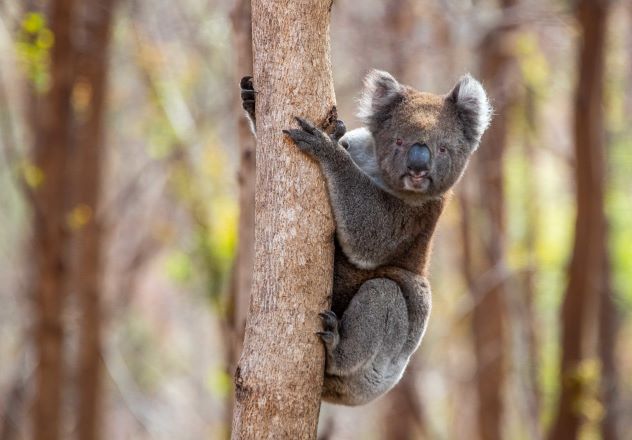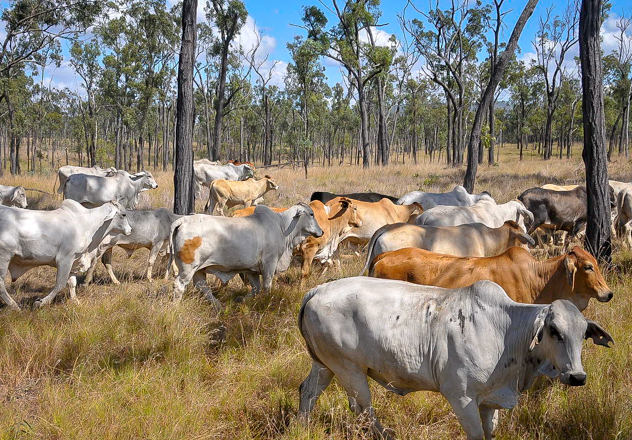Koalas inhabit eucalypt forests and woodlands in eastern Australia from north Queensland through to south-east South Australia. AWC protects populations of Koalas and their habitat on Curramore and Mount Zero-Taravale Wildlife Sanctuaries.

 Brad Leue
Brad Leue
AWC protects populations of Koalas and their habitat on Curramore and Mount Zero-Taravale Wildlife Sanctuaries. Fire management programs aim to reduce the frequency of wildfires at both sanctuaries.
 © Wayne Lawler/AWC
© Wayne Lawler/AWC
Loss of habitat poses a threat to Koalas in the south of their range, as the forests and woodlands of south-eastern Australia support intensive urban development and agriculture. Koalas are vulnerable to being attacked by dogs when on the ground; they are frequently run over by vehicles in urban areas. Intense wildfires can also adversely affect Koala populations.
 Wayne Lawler/AWC
Wayne Lawler/AWC
Koalas in the wild are best appreciated from a distance. If you are lucky enough to see a koala in the wild, please do not touch the koala or approach the tree it is in. Stay quiet while you watch the koala from afar, and then move away after a few minutes.

Description
Koalas are instantly recognisable with a large head, large furry ears, and large black furless nose; they have a stout body with a greatly reduced tail. They have grey-brown fur on the back and white underparts. They have poor vision but an excellent sense of smell which helps them detect food trees and other Koalas. Although almost entirely arboreal, they can move capably on the ground. Koalas are smaller in size, and less furry in the north of their range than in the south. In Queensland, female Koalas weigh five to six kg and males weigh six to eight kilograms. In Victoria, the average female weighs 8.5 kilograms and males weigh up to 12 kilograms.
Ecology
Koalas are specialists on the leaves of Eucalyptus trees. Although eucalypts are the dominant trees of many Australian ecosystems, the leaves of eucalypts are tough and contain high concentrations of toxic compounds. The complex digestive system of the Koala allows them to utilise eucalypt leaves as a food source, but the poor digestibility of eucalypt foliage places constraints on the energy budget of Koalas. Consequently, Koalas spend up to 20 hours per day sleeping. Most activity occurs at night, however, Koalas will move during the day if they are disturbed or if they get too hot or cold and need to find a new tree in which to rest.
Koalas can be difficult to observe in the wild. Ecologists conducting surveys for Koalas often search for their distinctive cylindrical scats beneath favoured food trees. The characteristic scratch marks made by Koalas on tree trunks and the loud bellowing grunting calls of males also provide evidence for the presence of the Koala.
Sexual maturity is attained after three to four years. Female Koalas give birth to a single young (rarely twins) at intervals at least a year apart; young develop slowly, spending over six months in the pouch and being weaned after a year.
Range and Abundance
Koalas inhabit eucalypt forests and woodlands in eastern Australia from north Queensland through to south-east South Australia; they are absent from Tasmania and Western Australia, although there is fossil evidence of the Koala in south-west Western Australia until the late Pleistocene. Within their range, Koalas are found in higher densities where preferred food trees are growing on fertile soils and along watercourses.
Donate to help protect the Koala and other vulnerable species from extinction
Donate NowCurramore Wildlife Sanctuary is home to a high abundance and diversity of wildlife, including 10 threatened vertebrate species. It protects a...
The Mount Zero-Taravale Sanctuary (Gugu Badhun country) covers a large area of spectacular landscape adjacent to the Wet Tropics World...
Situated less than three hours north of Sydney, on the Traditional Lands of the Worimi Nation, Waulinbakh Wildlife Sanctuary protects...
AWC protects the Western Quoll at Paruna and Mount Gibson Wildlife Sanctuaries using a comprehensive feral predator control program.
The Purple-crowned Fairy-wren is a small social bird found in dense riparian vegetation in northern Australia.
Pungalina-Seven Emu is the only mainland protected area in which the species occurs.